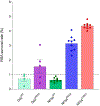Increasing Prevalence of Artemisinin-Resistant HRP2-Negative Malaria in Eritrea
- PMID: 37754284
- PMCID: PMC10539021
- DOI: 10.1056/NEJMoa2210956
Increasing Prevalence of Artemisinin-Resistant HRP2-Negative Malaria in Eritrea
Abstract
Background: Although the clinical efficacy of antimalarial artemisinin-based combination therapies in Africa remains high, the recent emergence of partial resistance to artemisinin in Plasmodium falciparum on the continent is troubling, given the lack of alternative treatments.
Methods: In this study, we used data from drug-efficacy studies conducted between 2016 and 2019 that evaluated 3-day courses of artemisinin-based combination therapy (artesunate-amodiaquine or artemether-lumefantrine) for uncomplicated malaria in Eritrea to estimate the percentage of patients with day-3 positivity (i.e., persistent P. falciparum parasitemia 3 days after the initiation of therapy). We also assayed parasites for mutations in Pfkelch13 as predictive markers of partial resistance to artemisinin and screened for deletions in hrp2 and hrp3 that result in variable performance of histidine rich protein 2 (HRP2)-based rapid diagnostic tests for malaria.
Results: We noted an increase in the percentage of patients with day-3 positivity from 0.4% (1 of 273) in 2016 to 1.9% (4 of 209) in 2017 and 4.2% (15 of 359) in 2019. An increase was also noted in the prevalence of the Pfkelch13 R622I mutation, which was detected in 109 of 818 isolates before treatment, from 8.6% (24 of 278) in 2016 to 21.0% (69 of 329) in 2019. The odds of day-3 positivity increased by a factor of 6.2 (95% confidence interval, 2.5 to 15.5) among the patients with Pfkelch13 622I variant parasites. Partial resistance to artemisinin, as defined by the World Health Organization, was observed in Eritrea. More than 5% of the patients younger than 15 years of age with day-3 positivity also had parasites that carried Pfkelch13 R622I. In vitro, the R622I mutation conferred a low level of resistance to artemisinin when edited into NF54 and Dd2 parasite lines. Deletions in both hrp2 and hrp3 were identified in 16.9% of the parasites that carried the Pfkelch13 R622I mutation, which made them potentially undetectable by HRP2-based rapid diagnostic tests.
Conclusions: The emergence and spread of P. falciparum lineages with both Pfkelch13-mediated partial resistance to artemisinin and deletions in hrp2 and hrp3 in Eritrea threaten to compromise regional malaria control and elimination campaigns. (Funded by the Bill and Melinda Gates Foundation and others; Australian New Zealand Clinical Trials Registry numbers, ACTRN12618001223224, ACTRN12618000353291, and ACTRN12619000859189.).
Copyright © 2023 Massachusetts Medical Society.
Figures



Comment in
-
Artemisinin-Resistant HRP2-Negative Malaria in Eritrea.N Engl J Med. 2023 Dec 28;389(26):2497. doi: 10.1056/NEJMc2312559. N Engl J Med. 2023. PMID: 38157512 No abstract available.
-
Artemisinin-Resistant HRP2-Negative Malaria in Eritrea. Reply.N Engl J Med. 2023 Dec 28;389(26):2497-2498. doi: 10.1056/NEJMc2312559. N Engl J Med. 2023. PMID: 38157513 No abstract available.
References
-
- World Health Organization. Report on antimalarial drug efficacy, resistance and response: 10 years of surveillance (2010–2019).2020.
-
- Noedl H, Socheat D, Satimai W. Artemisinin-resistant malaria in Asia. N Engl J Med 2009;361:540–1. - PubMed
Publication types
MeSH terms
Substances
Grants and funding
LinkOut - more resources
Full Text Sources
Other Literature Sources
